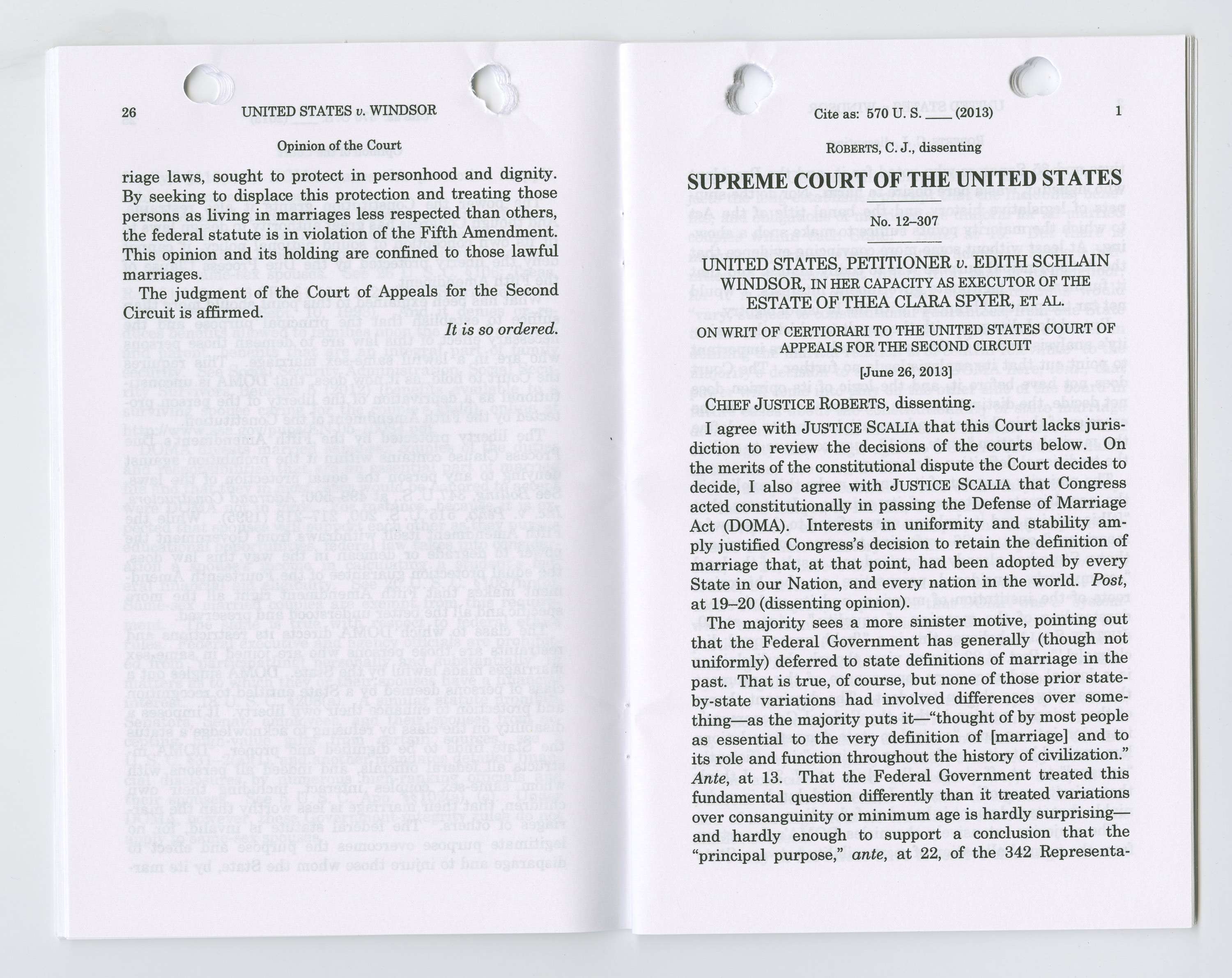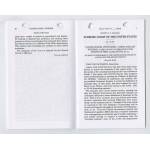Dissent of Chief Justice Roberts in U.S. v. Edith Windsor
6/26/2013

In 2010, Edith Windsor sued the Federal Government, claiming that DOMA violated the Equal Protection Clause under the Fifth Amendment. Windsor had been married to Thea Spyer. The two women met in New York City in 1963 and soon after began a long-term relationship. They entered a domestic partnership in 1993, when New York Mayor David Dinkins issued an executive order extending that right to same-sex couples, and were married in Ontario, Canada, in 2007.
When Spyer passed away in 2009 due to a heart condition, Windsor attempted to claim a Federal estate tax exemption for surviving spouses, but the IRS rejected her claims because DOMA held that the term "spouse" only applied to marriages between a man and a woman. As a result, Windsor was forced to pay $363,053 in Federal estate taxes.
Windsor sued for a full refund, arguing DOMA violated the Equal Protection Clause under the Fifth Amendment. The case made its way to the Supreme Court, and on June 26, 2013, the Court ruled in Windsor’s favor, deeming DOMA unconstitutional.
Although it did not legalize same-sex marriage, United States v. Windsor was a milestone in the fight for marriage equality. The decision forced the Federal Government to treat same-sex marriages equally under the law and made tax benefits previously restricted to opposite-sex couples available to same-sex couples. However, this ruling only extended to Federal laws; individual states did not have to recognize same-sex marriages.
The syllabus from the case – a summary added by the Court to help the reader understand the case and decision – is also available. The case also included two other dissenting opinions.
Transcript
SUPREME COURT OF THE UNITED STATES
_________________
No. 12–307
_________________
UNITED STATES, PETITIONER v. EDITH SCHLAIN WINDSOR, in her capacity as executor of the ESTATE OF THEA CLARA SPYER, et al.
on writ of certiorari to the united states court of appeals for the second circuit
[June 26, 2013]
Chief Justice Roberts, dissenting.
I agree with Justice Scalia that this Court lacks jurisdiction to review the decisions of the courts below. On the merits of the constitutional dispute the Court decides to decide, I also agree with Justice Scalia that Congress acted constitutionally in passing the Defense of Marriage Act (DOMA). Interests in uniformity and stability am- ply justified Congress’s decision to retain the definition of marriage that, at that point, had been adopted by every State in our Nation, and every nation in the world. Post, at 19–20 (dissenting opinion).
The majority sees a more sinister motive, pointing out that the Federal Government has generally (though not uniformly) deferred to state definitions of marriage in the past. That is true, of course, but none of those prior state-by-state variations had involved differences over something—as the majority puts it—“thought of by most people as essential to the very definition of [marriage] and to its role and function throughout the history of civilization.” Ante, at 13. That the Federal Government treated this fundamental question differently than it treated variations over consanguinity or minimum age is hardly surprising—and hardly enough to support a conclusion that the “principal purpose,” ante, at 22, of the 342 Representa- tives and 85 Senators who voted for it, and the President who signed it, was a bare desire to harm. Nor do the snip- pets of legislative history and the banal title of the Act to which the majority points suffice to make such a showing. At least without some more convincing evidence that the Act’s principal purpose was to codify malice, and that it furthered no legitimate government interests, I would not tar the political branches with the brush of bigotry.
But while I disagree with the result to which the major- ity’s analysis leads it in this case, I think it more important to point out that its analysis leads no further. The Court does not have before it, and the logic of its opinion does not decide, the distinct question whether the States, in the exercise of their “historic and essential authority to define the marital relation,” ante, at 18, may continue to utilize the traditional definition of marriage.
The majority goes out of its way to make this explicit in the penultimate sentence of its opinion. It states that “[t]his opinion and its holding are confined to those lawful marriages,” ante, at 26—referring to same-sex marriages that a State has already recognized as a result of the local “community’s considered perspective on the historical roots of the institution of marriage and its evolving un- derstanding of the meaning of equality.” Ante, at 20. Justice Scalia believes this is a “ ‘bald, unreasoned disclaime[r].’ ” Post, at 22. In my view, though, the disclaimer is a logical and necessary consequence of the argument the majority has chosen to adopt. The dominant theme of the majority opinion is that the Federal Government’s intrusion into an area “central to state domestic relations law applicable to its residents and citizens” is sufficiently “unusual” to set off alarm bells. Ante, at 17, 20. I think the majority goes off course, as I have said, but it is undeniable that its judgment is based on federalism.
The majority extensively chronicles DOMA’s departure from the normal allocation of responsibility between State and Federal Governments, emphasizing that DOMA “rejects the long-established precept that the incidents, benefits, and obligations of marriage are uniform for all married couples within each State.” Ante, at 18. But there is no such departure when one State adopts or keeps a definition of marriage that differs from that of its neighbor, for it is entirely expected that state definitions would “vary, subject to constitutional guarantees, from one State to the next.” Ibid. Thus, while “[t]he State’s power in defining the marital relation is of central relevance” to the majority’s decision to strike down DOMA here, ibid., that power will come into play on the other side of the board in future cases about the constitutionality of state marriage definitions. So too will the concerns for state diversity and sovereignty that weigh against DOMA’s constitutionality in this case. See ante, at 19.
It is not just this central feature of the majority’s analysis that is unique to DOMA, but many considerations on the periphery as well. For example, the majority focuses on the legislative history and title of this particular Act, ante, at 21; those statute-specific considerations will, of course, be irrelevant in future cases about different statutes. The majority emphasizes that DOMA was a “system- wide enactment with no identified connection to any particular area of federal law,” but a State’s definition of marriage “is the foundation of the State’s broader author- ity to regulate the subject of domestic relations with respect to the ‘[p]rotection of offspring, property interests, and the enforcement of marital responsibilities.’ ” Ante, at 22, 17. And the federal decision undermined (in the majority’s view) the “dignity [already] conferred by the States in the exercise of their sovereign power,” ante, at 21, whereas a State’s decision whether to expand the definition of marriage from its traditional contours involves no similar concern.
We may in the future have to resolve challenges to state marriage definitions affecting same-sex couples. That issue, however, is not before us in this case, and we hold today that we lack jurisdiction to consider it in the particular context of Hollingsworth v. Perry, ante, p. ___. I write only to highlight the limits of the majority’s holding and reasoning today, lest its opinion be taken to resolve not only a question that I believe is not properly before us—DOMA’s constitutionality—but also a question that all agree, and the Court explicitly acknowledges, is not at issue.
Rights: Public Domain, Free of Known Copyright Restrictions. Learn more on our privacy and legal page.






